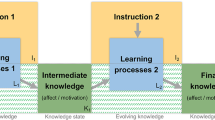Abstract
Visualization techniques involving the analysis of pictorial information (e.g., photographs, paintings, and geometric forms) are used to guide students' understanding of the composing process. For the first exploratory study sets of papers written by students enrolled in an introductory level composition course incorporating these techniques were compared with sets of papers written by students in another section of the same course to determine the effectiveness of visualization for understanding the process of revision. Students in a second study completed a questionnaire designed to assess students' memory for visualization techniques as well as their tendency to apply these techniques to new situations. The results suggest that visualization techniques were effective in guiding the revision process (Study 1). Further, results show that students remembered both specific details about the pictorial information used to guide the composing process (outlining, analyzing, revising) and the underlying principles informing these techniques (Study 2). Visualization techniques are discussed in terms of their potential usefulness in reducing the cognitive demands implicit in the composing process.
Similar content being viewed by others
References
Alesandrini, K. (1982). Imagery eliciting strategies and meaningful learning,Journal of Mental Imagery 6: 125–140.
Anderson, J. (1980).Cognitive psychology and its implications, 2nd ed., pp. 453–464. San Francisco, CA: W.H. Freeman & Co.
Arnheim, R. (1969).Visual thinking. Berkeley: University of California Press.
Arnheim, R. (1986). A plea for visual thinking. In:New Essays on the Psychology of Art (pp. 135–138). Berkeley: University of California Press.
Bransford, J. & Johnson, M. K. (1973). Consideration of some problems in comprehension. In: W. Chase (ed.),Visual information processing (pp. 353–438). New York: Academic Press.
Denis, M. (1982). Imagining while reading text: A study of individual differences,Memory & Cognition 10: 540–545.
Denis, M. (1984). Imagery and prose: A critical review of in adults and children,Text 4: 381–401.
Flower, L. (1981). Writer-based prose: A cognitive basis for problems in writing. In: G. Tate and E. P. J. Corbett (eds.),The writing teacher's sourcebook (pp. 268–292). New York: Oxford University Press.
Flower, L. (1985).Problem solving strategies for writing, 2nd ed. New York: Harcourt, Brace, Jovanovich.
Foley, M. A., Wilder, A., McCall, R. & von Vorst, R. (1993). Children's use of spontaneous imaginations in the absence of external supports,Journal of Experimental Child Psychology 56: 173–200.
Giesen, C. & Peeck, J. (1984). Effects of imagery instruction on reading and retaining a literary text,Journal of Mental Imagery 8: 79–90.
Golden, C. (1986). Composition: Writing and the visual arts,Journal of Aesthetic Education 20: 59–68.
Golden, C. (1988). Visual thinking and the process of composition,Salmagundi 78/79: 97–112.
Hunter, P., Moore, D. & Wildman, J. (1982). The effects of presentation mode, imagery ability, and the type of stimulus material on learning,Journal of Mental Imagery 6: 175–182.
McDaniel, M. A. & Pressley, M. (1987).Imagery and Related Mnemonic Processes. New York: Springer Verlag.
Moffett, J. (1981).Coming on center. Montclair, NJ: Boynton/Cook Publishers.
Paivio, A. (1971).Imagery and verbal processes. New York: Holt, Rinehart & Winston.
Paivio, A. (1983). The mind's eye in arts and sciences,Poetics 12: 1–18.
Paivio, A. & Harshman, R. (1983). Factor analysis of a questionnaire on imagery and verbal habits and skills,Canadian Journal of Psychology 37: 461–483.
Sadoski, M. (1985). The natural use of imagery in story comprehension and recall: A replication and extension,Reading Research Quarterly 20: 658–667.
Schneider, W. & Pressley, M. (1989).Memory development between 2 and 20. New York: Springer Verlag.
Shaughnessy, M. (1977).Errors and Expectations: A Guide for the Teacher of Basic Writing. New York: Oxford University Press.
Vygotsky, L. (1962).Thought and language. Cambridge, MA: M.I.T. Press.
Author information
Authors and Affiliations
Rights and permissions
About this article
Cite this article
Golden, C., Foley, M.A., Holtz, K. et al. Visualization as a guide for composing. Read Writ 6, 197–214 (1994). https://doi.org/10.1007/BF01026912
Issue Date:
DOI: https://doi.org/10.1007/BF01026912




